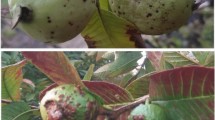Abstract
This paper reports detailed studies and observations made on five isolates of the common mycoparasite on powdery mildews viz.Ampelomyces quisqualis Ces. in artificial culture. The results revealed some significant variations among these isolates in respect of morphological characters of pycnidia and pycnidiospores and colony characters, which provide evidence on the existence of physiologic forms within this species of the hyperparasite.
Similar content being viewed by others
References
Ainsworth, G. C. (1961) Ainsworth & Bisby's Dictionary of the Fungi. 5th Edition, C.M.I. England.
Bary, A. de, (1870)Eurotium, Erysiphe, Cicinnobolus: Nebst Bemerkungen ueber die Geschlechtsorgane der Ascomyceten.Abhand. Senek. Natur. Ges. 7:361–455.
Bhatnagar, M. K., Kothari, K. L. &Porwal, S. (1966) A New Record of HyperparasiteSci. & Cult. 32:89–90.
Cesati, V. (1852)Ampelomyces quisqualis Ces. MSS. In: Klotzschii Herbarium vivum mycologicum ... Centuria XVII cura Ludovici Rabenhorst.Bot. Zeit. 10:301–302 (Also inFlora 35:395–399, 1852).
Chona, B. L. &Munjal R. L. (1956)Cicinnobolus cesatii de Bary — Hyperparasite of powdery mildews in India. Ind.Phytopath. 9:98–105.
Emmons, C. W. (1930)Cicinnobolus cesatii, a study in host-parasite relationships.Bull. Torrey Bot. Club 57:421–441.
Kamat, M. N. &Patwardhan, P. G. (1966) HyperparasiteAmpelomyces and its Role in the Development of Powdery Mildews. The Proceedings of the Autumn School in Botany, Mahabaleshwar, 1966; 132–137.
Kothari, K. L. &Bhatnagar, M. K. (1966) Two New Records of Hyperparasites on Powdery Mildews.Ind. Phytopath. 14:314.
Patwardhan, P. G. (1964) Occurrence ofAmpelomyces (=Cicinnobolus) as a hyperparasite on Powdery Mildew Fungi in Bombay-Maharashtra.Mycopath. et Mycol. Appl. 23:45–46.
Prasad, N., Agnihotri, J. P., &Tyagi, R. N. S. (1960) Fungicole Parasite from Rajasthan — I.Sci. & Cult. 26:284.
Rao, P. N. &Salam, M. A. (1959) Hyperparasite on Powdery Mildews.Sci. & Cult. 24:574.
Rayner, R. W. (1970) A Mycological Colour Chart. C.M.I. Kew, Surrey & Brit. Mycol. Soc.
Rogers, D. P. (1959) OnCicinnobolus.Mycologia 51:96–98.
Sydow, H. &Sydow P. Butler, E. J. (1916) Fungi Indiae Orientalis Pars IV.Ann. Mycol. 14:190.
Venkatrayan, S. V. (1946) A Natural Fungus Parasite of Powdery Mildew onCyamopsis psoralioides DC.Curr. Sci. 15:319.
Author information
Authors and Affiliations
Rights and permissions
About this article
Cite this article
Mhaskar, D.N. Mycoparasite-Ampelomyces in artificial culture I. Morphology and cultural behaviour. Mycopathologia et Mycologia Applicata 52, 55–64 (1974). https://doi.org/10.1007/BF02128736
Accepted:
Issue Date:
DOI: https://doi.org/10.1007/BF02128736




